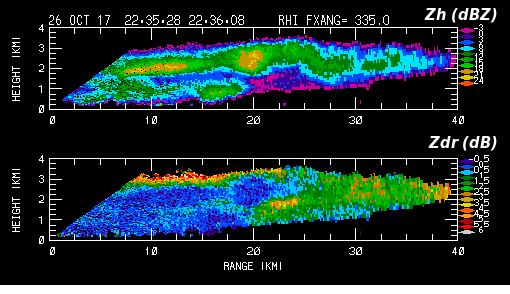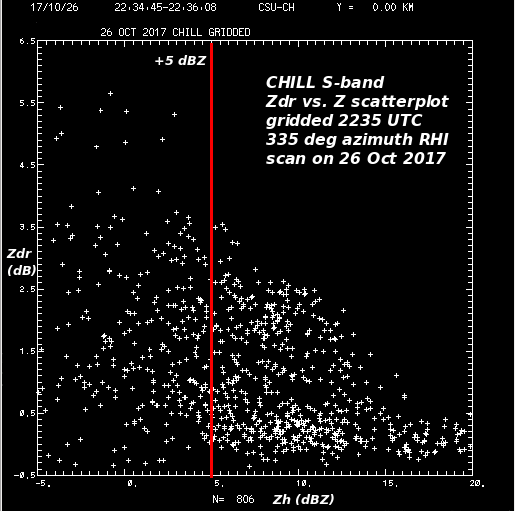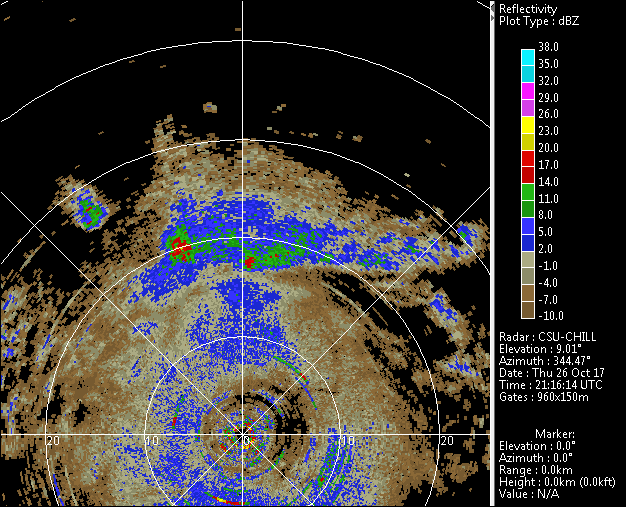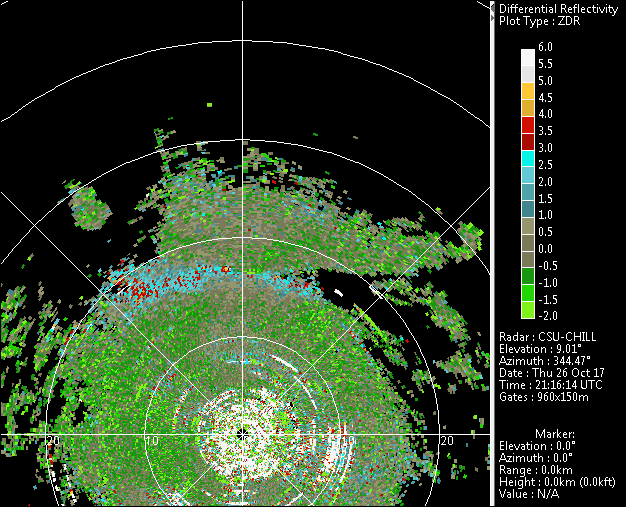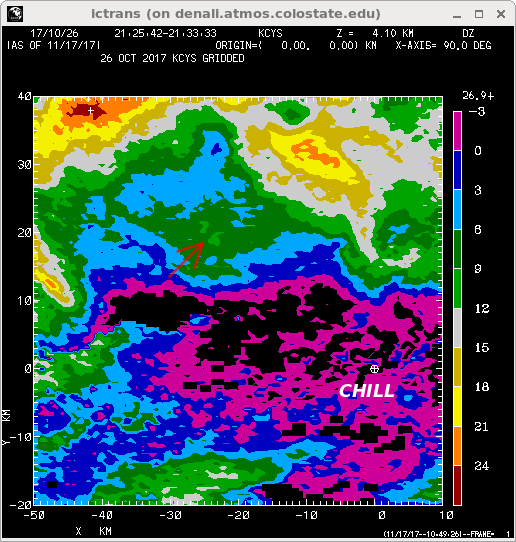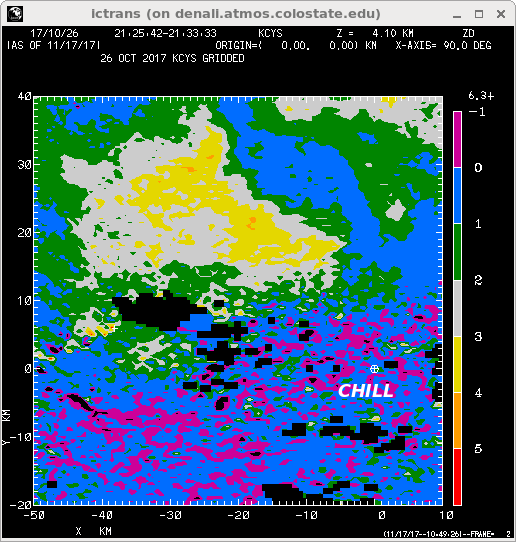DPWX/Zdr evolution in snow showers: 26 October 2017: Difference between revisions
Pat kennedy (talk | contribs) (Adding front page material.) |
Pat kennedy (talk | contribs) (Initial text addition.) |
||
| Line 12: | Line 12: | ||
==Overview== | |||
During the afternoon hours of 26 October 2017, an unstable airmass was in the vicinity of the CSU-CHILL radar following a morning cold frontal passage. Local showers developed in this environment. At the radar site, surface air temperatures were near freezing and the precipitation was snow. Ground temperatures were still above freezing and no snow accumulation occurred. | |||
==9 degree elevation angle PPI image loops== | |||
To monitor the evolution of near-range echo at upper levels, the CSU-CHILL conducted continuous surveillance scans at an elevation angle of 9.0 degrees. The scan rate of 6 degrees per second provided an essentially once per minute update rate. The following image loop shows the reflectivity data in the 9 degree elevation scans conducted between 2116 and 2200 UTC. The general echo motion from the west-northwest in the post-frontal flow is apparent. One feature of particular interest is the new echo that initially develops near the 20 km range ring in the northwest azimuth quadrant. With time, this echo intensifies to > 14 dBZ (red) reflectivity and moves to closer ranges and lower heights. | |||
<center> | <center> | ||
| Line 62: | Line 69: | ||
</center> | </center> | ||
The second loop shows the corresponding differential reflectivity (Zdr) data. The developing echo area in the northwest azimuth quadrant is initially characterized by distinctly positive Zdr levels in the +4 to + 6 dB range. During the subsequent period of reflectivity intensification, the Zdr values decrease rapidly towards 0 dB. This process results in the intensifying echo transitioning to a low Zdr "hole" within the surrounding echo area. Zdr is a measure of the reflectivity-weighted mean axis ratio of the backscattering particles in the radar pulse volume. Thus, the Zdr decrease from the hydrometeors in the intensifying snow shower indicates a transition towards some combination of less oblate (i.e. more spherical) particle shapes and more random orientations. This pattern is consistent with the aggregation of individual planar ice crystal forms into more irregularly shaped aggregates. | |||
<center> | <center> | ||
Revision as of 07:13, 25 November 2017
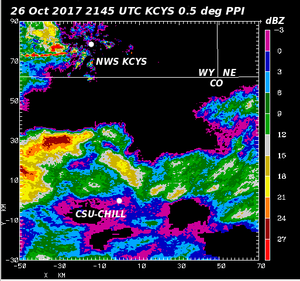
Showers, primarily snow, as seen in the reflectivity data collected by the NWS Cheyenne, WY radar in a 0.5 deg elevation scan on 26 October 2017. The CSU-CHILL radar collected continuous 9 deg elevation surveillance scans during this same time period. Differential reflectivity variations of several dB were observed in the snow showers near the CSU-CHILL radar.
Overview
During the afternoon hours of 26 October 2017, an unstable airmass was in the vicinity of the CSU-CHILL radar following a morning cold frontal passage. Local showers developed in this environment. At the radar site, surface air temperatures were near freezing and the precipitation was snow. Ground temperatures were still above freezing and no snow accumulation occurred.
9 degree elevation angle PPI image loops
To monitor the evolution of near-range echo at upper levels, the CSU-CHILL conducted continuous surveillance scans at an elevation angle of 9.0 degrees. The scan rate of 6 degrees per second provided an essentially once per minute update rate. The following image loop shows the reflectivity data in the 9 degree elevation scans conducted between 2116 and 2200 UTC. The general echo motion from the west-northwest in the post-frontal flow is apparent. One feature of particular interest is the new echo that initially develops near the 20 km range ring in the northwest azimuth quadrant. With time, this echo intensifies to > 14 dBZ (red) reflectivity and moves to closer ranges and lower heights.
|
|
||
|
The second loop shows the corresponding differential reflectivity (Zdr) data. The developing echo area in the northwest azimuth quadrant is initially characterized by distinctly positive Zdr levels in the +4 to + 6 dB range. During the subsequent period of reflectivity intensification, the Zdr values decrease rapidly towards 0 dB. This process results in the intensifying echo transitioning to a low Zdr "hole" within the surrounding echo area. Zdr is a measure of the reflectivity-weighted mean axis ratio of the backscattering particles in the radar pulse volume. Thus, the Zdr decrease from the hydrometeors in the intensifying snow shower indicates a transition towards some combination of less oblate (i.e. more spherical) particle shapes and more random orientations. This pattern is consistent with the aggregation of individual planar ice crystal forms into more irregularly shaped aggregates.
|
|
||
|
|
|
||
|
|
|
||
|
